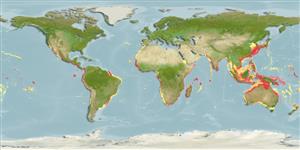Common names from other countries
Elasmobranchii (haaien en roggen) (sharks and rays) >
Myliobatiformes (Stingrays) >
Mobulidae (Devilrays)
Etymology: japanica: Named for Japan..
More on authors: Müller & Henle.
Issue
This species is considered as a junior synonym of Mobula mobular according to Last et al., 2016 (Ref. 114953) and White et al., 2017 (Ref. 115945:13). The species page will be removed,.
Environment: milieu / climate zone / depth range / distribution range
Ecologie
marien rifbewoner; diepte 0 - 647 m (Ref. 106604), usually 0 - 200 m (Ref. 89423). Subtropical; 40°N - 30°S
Indo-Pacific: off South Africa, the Arabian Sea eastward to the Hawaiian Islands and Polynesia. Eastern Pacific: on the continental coast. Eastern Atlantic: Côte d'Ivoire but may probably be more wide-ranging. This has to be critically compared with Mobula mobular of the Mediterranean Sea and nominally elsewhere in the North Atlantic.
Lengte bij maturiteit / Grootte / Gewicht / Leeftijd
Maturity: Lm 217.8, range 204 - ? cm
Max length : 310 cm WD mannelijk / geslacht onbekend; (Ref. 50641); 240.0 cm WD (female); common length : 225 cm WD mannelijk / geslacht onbekend; (Ref. 9256)
Dark blue to black above, white below. Inner surface of cephalic fins silver grey with black tip, outer surface and side behind eye white (Ref. 11228). Shared characters between M. rancureli and Mobula japanica: teeth, placoid scales, and branchial filter morphologies, morphometrics, presence of tail spine, distinctive shape and coloration of dorsal fin, and general shape of body and coloration (Ref. 50641).
Found inshore, possibly in oceanic waters (Ref. 9911). Pelagic (Ref. 58302). Occurs singly or in groups (Ref. 9911). Feeds mainly on euphausiids (mainly Nictiphanes simplex), and to a lesser extent on copepods and crustacean larvae. May also feed on small fishes. Ovoviviparous (Ref. 50449). Acoustic tracks record the species to spend time above the thermocline at night to feed on krill (H. Dewar, pers.comm. 05/2000). Very common by-catch of the gillnet fisheries targeting skpjack tuna (Katsuwonus pelamis). Utilized for its gill filter plates (very high value), meat, cartilage and skin (Ref.58048).
Exhibit ovoviparity (aplacental viviparity), with embryos feeding initially on yolk, then receiving additional nourishment from the mother by indirect absorption of uterine fluid enriched with mucus, fat or protein through specialised structures (Ref. 50449). With one in a litter (Ref. 12951). Size at birth 85-92 cm WD (Ref. 12951, Ref.58048).
Last, P.R. and J.D. Stevens, 1994. Sharks and rays of Australia. CSIRO, Australia. 513 p. (Ref. 6871)
Status op de Rode Lijst van het IUCN (Ref. 130435)
Gevaar voor de mens
Harmless
Gebruik door de mens
Visserij: commercieel
Meer informatie
ReferentiesAquacultuurAquacultuurprofielKweeklijnenGeneticaElectrophoresesErfelijkheidZiektesVerwerkingMassaconversie
Tools
Speciale rapporten
Download XML
Internetbronnen
Estimates based on models
Preferred temperature (Ref.
115969): 17.5 - 29, mean 27.4 (based on 5840 cells).
Fylogenetische diversiteitsindex (Ref.
82804): PD
50 = 0.5005 [Uniqueness, from 0.5 = low to 2.0 = high].
Bayesian length-weight: a=0.01000 (0.00244 - 0.04107), b=3.04 (2.81 - 3.27), in cm Total Length, based on all LWR estimates for this body shape (Ref.
93245).
Trofisch niveau (Ref.
69278): 3.4 ±0.43 se; based on food items.
Weerstandsvermogen (Ref.
120179): Zeer laag, minimale populatieverdubbelingstijd meer dan 14 jaar (Fec=1).
Fishing Vulnerability (Ref.
59153): High vulnerability (58 of 100).
